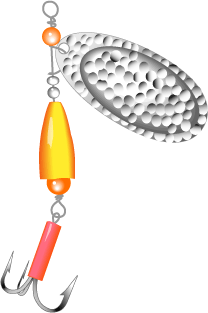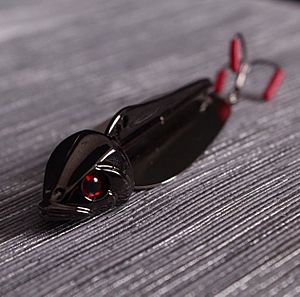Fishing lure facts for kids
A fishing lure is a special tool used to catch fish. It's like a fake snack for fish! You tie it to your fishing line. Lures are designed to look and move like something a fish would want to eat. They often have bright colors or shiny parts. Each lure has fishing hooks to help catch the fish. You usually use a lure with a fishing rod. You cast (or throw) the lure into the water. Then, you pull it back slowly. Smart anglers can throw lures near places where fish hide, like under logs.
There are many kinds of fishing lures. Most are made to look like fish that are dying, hurt, or moving fast. They can be made from wood, plastic, rubber, metal, cork, feathers, or animal hair. Some lures are shiny to grab a fish's attention.
Contents
Who Invented Fishing Lures?
The first modern fishing lure was invented by accident in 1890. A man named James Heddon was carving wood. He shaped a piece of wood like a frog. He then threw it into the water. To his surprise, a bass fish immediately bit it! The next day, James Heddon started a company called the Heddon Company. This was the beginning of fishing lures as we know them.
Types of Fishing Lures
There are many different types of fishing lures. Most are made to look like food that fish eat. But some are designed to make fish curious or even a little aggressive. Here are some common types:
- Jigs: A jig is a hook with a weight, usually made of lead. They often have a fake minnow, crawfish, or plastic worm attached. This helps get the fish's attention. Some jigs used in deep saltwater can go down to 300 meters!
- Surface Lures: Also called topwater lures or poppers, these lures float on top of the water. They look like prey that is swimming on the surface. Some can even make popping or buzzing sounds. It takes practice to use these lures well.
- Spoon Lures: These lures look like a spoon. They have a wide, rounded end and a narrower, pointed end. Their shape makes them flash and wobble in the water. This movement attracts fish.
- LED Lures: These lures have a small LED light and a battery inside. They flash or strobe with different colors. The lights help attract fish, especially in darker waters.
- Plugs: Also known as crankbaits or minnows, these lures look like small fish. They have a special lip (called a bib) at the front. This bib makes them move in different ways when pulled through the water.
- Artificial Flies: These are lures designed to look like insects or other small creatures. They are used with a special fly rod and reel in fly fishing.
- Soft Plastic Baits: These lures are made from soft plastic or rubber. They can look like fish, crabs, worms, lizards, or frogs. They feel very real to a fish.
- Spinnerbaits: A spinnerbait is a wire bent at an angle. It has a hook at the bottom and a shiny spinner blade at the top. The blade spins and flashes, attracting fish.
- Swimbaits: This is a soft plastic lure that looks very much like a real bait fish. Some swimbaits have a tail that makes them look like they are swimming when pulled through the water.
- Fish Decoys: These are traditional lures, often carved from wood. They look like fish, frogs, or insects. Fishermen use them to attract fish, especially when fishing through ice. The Inuit people have used them for centuries as part of their diet.
How Lures Help the Environment
Using artificial lures has some good points for the environment. One big advantage is that you don't need to use live bait. This helps protect smaller fish species that are often caught for bait. These small fish are important for the ocean's food chain.
Another benefit of lures is that they help fish survive better when you practice catch and release fishing. Lures are less likely to hook a fish deeply. This means the fish are less harmed and have a better chance of living after being released.
Images for kids








